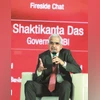Economic growth in India in the second quarter this financial year is likely to surprise on the upside, said Reserve Bank of India (RBI) Governor Shaktikanta Das on Tuesday.
Speaking at the Business Standard BFSI Insight Summit, Das said: “Looking at the momentum of economic activity, looking at a few early indicators, I can say that the second-quarter GDP number, as and when it is released, at the end of November, in all probability will surprise everyone on the upside.”
The RBI has projected a GDP growth rate of 6.5 per cent for July-September while growth for 2023-24 too is seen at 6.5 per cent.
Das said for the central bank inflation had priority over growth. “We look at inflation-growth dynamics. The first priority is inflation at the moment, and based on that we decide policy,” he said.
After raising the repo rate by 250 bps between May 2022 and February 2023, the six-member Monetary Policy Committee has maintained its status in the next four policies.
Also Read
The next policy review is scheduled for December.
Das said the evolving geopolitics posed a challenge globally, affecting financial markets and global growth. Despite these risks, India is well-positioned to handle such situations compared to other nations, providing confidence in its ability to navigate these challenges.
“Geopolitics poses the biggest risk for growth not just in India but for the world as a whole. To some extent it has pulled down global growth. So far as India is concerned, even with all geopolitical risks, I can say with confidence that India is well placed compared to other countries to deal with such risky or potentially risky situations,” he said.
Das further said internationalising the rupee, “like we have said over the years with regard to capital account convertibility”, was an ongoing process rather than a fixed target.
“There is a phased road towards it.”
He said it was not the question of pitting the rupee against the dollar, but the aim was to enhance the presence of the rupee in international trade, particularly with countries where India had strong and active trade ties. The approach is necessary because the size, presence, and impact of the Indian economy on the global stage are expanding significantly, he said.
The governor said a large chunk of outflows in September and October was associated with payments for imports because repayments of previous external commercial borrowing too were scheduled. He said the percentage of outflows related to equities was low when compared to the total.
After staying positive for six straight months, foreign portfolio investment outflows in September were Rs 16,026 crore and Rs 21,680 crore till October 30.

)
